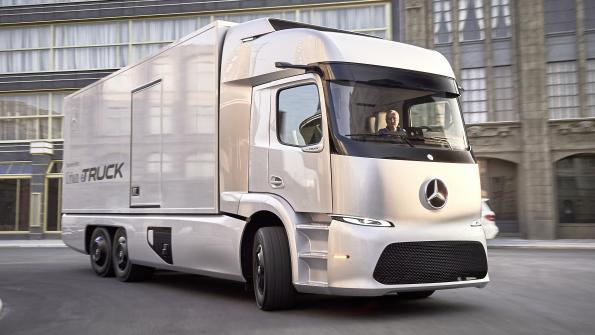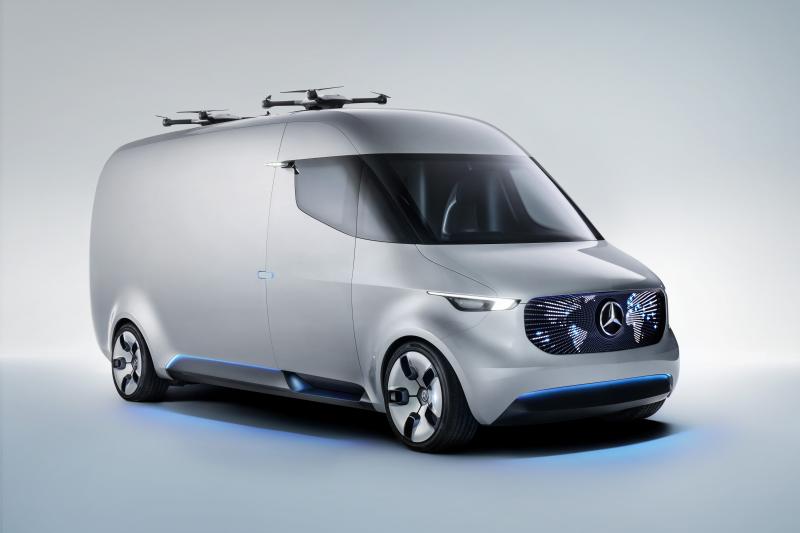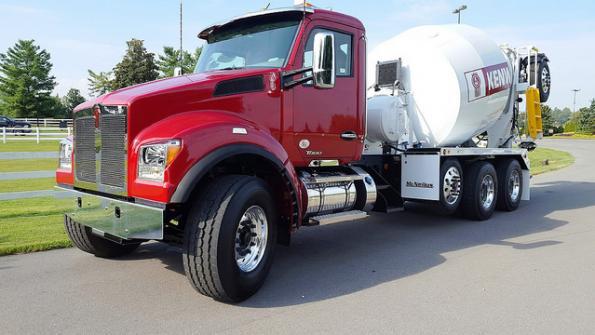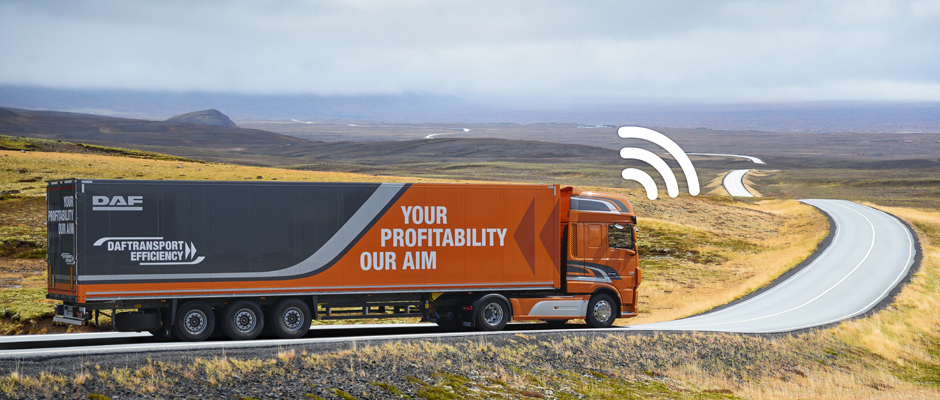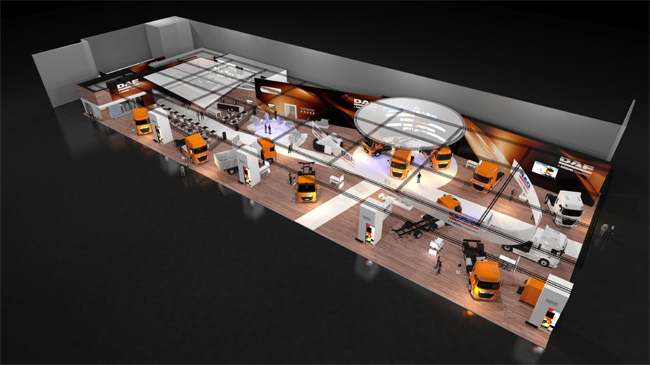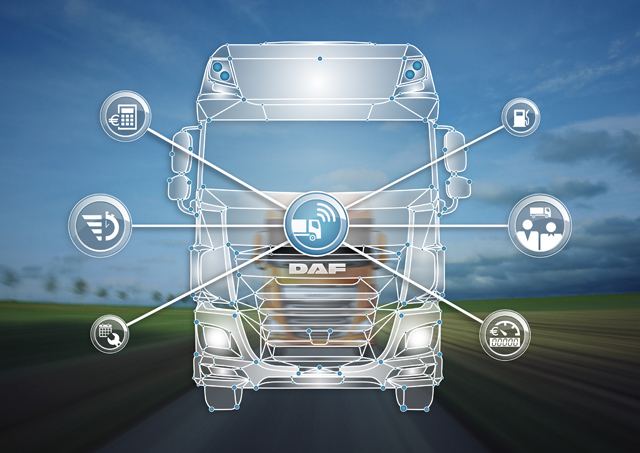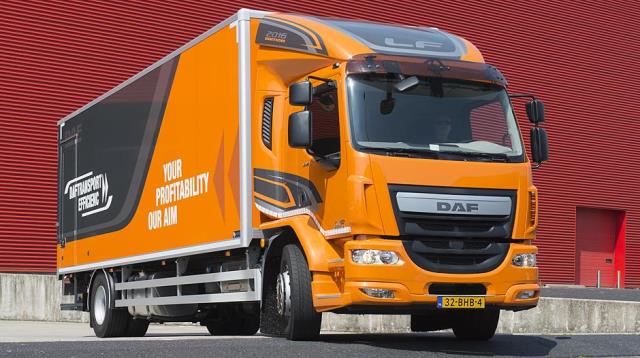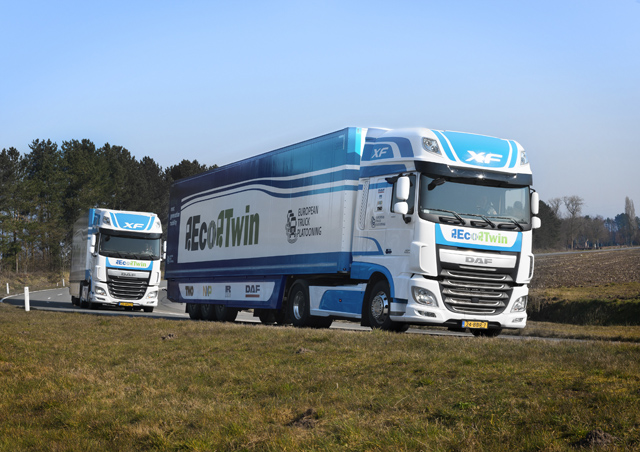
kscarbel2
Moderator-
Posts
17,893 -
Joined
-
Days Won
86
Content Type
Profiles
Forums
Gallery
Events
Blogs
BMT Wiki
Collections
Store
Everything posted by kscarbel2
-
Dodge (Ram) Trucks / September 20, 2016 . . . . . .
-
Dodge (Ram) Trucks / September 20, 2016 . . .
-
Daimler’s take on urban trucking Fleet Owner / September 20, 2016 Advanced eTruck, van and bus concept vehicles are unveiled at world’s largest commercial vehicle show Advanced truck and bus technology for urban environments have taken center stage for Daimler at IAA 2016, the world’s largest commercial vehicle show. Having introduced its autonomous long-haul truck technology at the last IAA show in 2014, this time Daimler’s truck group rolled out a concept “Urban eTruck” with a 200 km range, while it’s van division showed an always-connected light vehicle meant to integrate last-mile delivery into advanced supply chain distribution systems. Using technology first shown in its Future Truck back in 2014, Daimler’s Mercedes-Benz Bus group this year also premiered the MB Future Bus with autonomous driving capability. The Mercedes-Benz Urban eTruck is a fully electric 6x2 cabover with refrigerated body and 26-ton GVW. Power is delivered by two electric motors mounted at the drive wheel ends. A modular battery package design allows users to specify the proper storage capacity for their individual operations, with the standard three-battery module providing a range of up to 200 km, according to Daimler. A more compact two-battery module offers increased payload for shorter distances, and a four-battery package extends range at the cost of carrying capacity. All three rely on regenerative braking to recharge the batteries during operation. Inside the concept Urban eTruck, twin 12-in. displays provide all control and operating information while automated drive controls adjust vehicle speed and braking based on actual road and traffic conditions. Battery-charge state and use forecasts are also always displayed, allowing drivers to choose from power, normal and “eco” drive modes depending on available battery power and need. Central to the Urban eTruck’s efficiency is full integration with Daimler’s FleetBoard telematics system. It not only allows dispatchers to remotely monitor the truck’s operations, but helps them plan routes and loads to maximize the electric truck’s efficiency. Daimler said standard production of this type of urban truck “would be conceivable from the start of the next decade.” Similar but in a smaller package, the Mercedes Benz Vision Van is a concept vehicle designed to function as an element in an integrated and digitally connected supply chain system. An electrically powered zero-emissions vehicle with a range of up to 270 km, it is intended for last-mile deliveries completed by autonomous drones. It functions as part of a fully automated cargo management system that picks orders, sequences packages, optimizes routes and automates vehicle loading. The van’s interior workspace uses a joy-stick control, eliminating steering wheel, pedals and center console for a large driver work area. Building on the autonomous driving technology introduced in the Mercedes-Benz Future Truck in 2014, the MB Future Bus takes that technology a few steps further for urban applications. Its ‘CityPilot” system can operate fully autonomously for up to 20 km, handling all steering, accelerating and braking by reading road signs and traffic lights, detecting obstacles and pedestrians and operating the bus doors at stops. The concept bus is based on the current MB Citaro bus, but employs an unusual passenger compartment design Daimler says is based on public parks and squares. Passengers can chose between a standing room only “express” area for short trips or a ‘lounge” with asymmetrically placed seating for longer ones. Overhead consoles with 43-in. monitors keep passengers fully informed and entertained. While the concept bus shown at IAA is powered by MB 6-cyl. diesel, the company says it could also be fitted with its M936G natural gas engine or a forthcoming battery-powered electric drive for city buses due in 2018. .
-
Fleet Owner / September 20, 2016 Kenworth expanded its T880 with a set-forward front axle configuration at the ConcreteWorks show hosted by the National Ready Mix Concrete Association (NRMCA). The new configuration, named the T880S, is designed for fleet and truck operators in ready-mix, dump and mobile crane applications, the company said. “The new T880S advances Kenworth’s heritage of providing fleets and truck operators with industry-leading, rugged and reliable vocational trucks that deliver excellent performance,” said Jason Skoog, Kenworth assistant general manager for sales and marketing. “Available with a 114-inch BBC and best-in-class 28-inch bumper setting, tare weight is minimized, weight distribution is optimized, Federal Bridge Formula can easily be met, and body installations are enhanced.” According to the company, the bumper setting is important in spec’ing Bridge Formula chassis required to stay under the 40-foot length limit. Also offered are 29.5-inch and 31.5-inch bumper settings. Truck operators can specify the mixer tapered (114-inch BBC), dump tapered (115.5-inch BBC) or straight box bumpers (117.5-inch BBC) in a variety of finishes and materials. Removable and cast center-mounted tow hooks are available, depending on bumper selection, Kenworth said. The new T880S is available with a set-forward front axle ranging from 14,600 to 22,800 lbs., the company noted. Single, tandem or tridem drive axles and a wide variety of factory-installed lift axles, are among a range of options. “This T880S has excellent visibility, enhanced by a 3.6-inch lower hood crown than the legacy Kenworth W900S for up to four feet of additional ground visibility,” according to Kenworth. “Utilizing technology from the proven T880 product line, the newly styled, complex reflector halogen headlight provides projector beam lighting performance without the extra cost, along with a thick, polycarbonate lens and UV inhibitor for long life.” The T880 and T880S are standard with the 12.9-liter Paccar MX-13 engine, which provides up to 500-hp and 1,850 lb-ft of torque. Kenworth Press Release - http://www.kenworth.com/news/news-releases/2016/september/t880s/ .
-
Daimler looks to revolutionize urban deliveries with electric vehicles Truck News / September 22, 2016 With 70% of the world’s population expected to live in cities by 2050, Daimler demonstrated at the IAA Commercial Vehicles Show how it plans to make cities more livable. “We will make distribution in big cities emissions-free very soon,” said Dr. Wolfgang Bernhard, head of Daimler Trucks globally. At the heart of its announcements at the show was a new all-electric and fully connected concept Mercedes-Benz Urban eTruck, which the company says will be able to produce no local emissions or noise. The triple axle concept truck has a gross weight rating of 26 tons and can perform as well as a diesel-powered truck, Daimler said. Bernhard said better batteries that are available for less money will soon make electric urban delivery vehicles viable. “Urban areas will get more complex and our cars and trucks should make life easier,” said chief designer Gorden Wagener. “The Urban eTruck is a prime example that beauty and intelligence can go hand in hand in our commercial vehicles.” Daimler showed the eTruck to a gathering of more than 600 guests from 36 countries on the eve of the IAA Commercial Vehicles Show. The company reduced the weight impairment normally associated with electric vehicles to just 1,700 kgs. The truck is propelled by an electrically powered rear axle, with electric motors adjacent to the wheel hubs. The truck can operate in auto, agile and eco modes, depending on battery power levels and the requirements of the route. The eTruck can travel 200 kms on a single charge and can be recharged in less than two hours, according to Sven Ennerst, head of product engineering and global procurement for Daimler. Drivers can view in real-time the planned and actual range and the truck will switch modes when necessary to conserve power and ensure it reaches its destination. Daimler also announced an all-electric Fuso eCanter medium-duty truck, which will be offered in Europe, Japan and the US in 2018. It has a 100-km range and reduces total cost of operation by 40%, the company announced. Daimler said as much as 80% of urban transport involves routes of no more than 50 kms per day, making the eCanter an ideal vehicle. Only four batteries are needed to power the truck for the day, but for routes that extend to 100 kms or more, a fifth battery is available. Daimler projects the operational savings will provide a payback in less than three years. Daimler also enhanced the safety of its urban delivery trucks with the introduction of Active Brake Assist 4, its first brake assist system with pedestrian detection. Automated alerts and active braking are employed at speeds of up to 50 km/h when a pedestrian is detected. A new Sideguard Assist system uses short-range radar to detect objects – including pedestrians and cyclists – along the right-hand side of the vehicle. Visual and audible alerts are issued so the driver can prevent contact with objects or people along the side of the truck. The new safety systems are being offered on Mercedes-Benz trucks in Europe. Of course, many urban deliveries are completed via van, and Daimler introduced a new Vision Van concept for this purpose. The electrically powered Vision Van comes complete with roof-mounted drones that can fetch a package from the cargo compartment and deliver it to a receiver. The drones have a range of 10 kms and payload capacity of two kilograms. Mercedes will be producing fully electric eDrive vans by 2018, the company announced. Volker Mornhinweg, head of Mercedes-Benz vans, insisted performance won’t be compromised when compared to today’s diesel-fueled vans. The Vision Van features a 75 kW electric drive system that can run up to 270 kms with no local emissions or noise.
-
IAA 2016 - 2017 VW Amarok "Canyon" package mid-size pickip
kscarbel2 posted a topic in Odds and Ends
-
Volvo Trucks - Press conference from IAA in Hannover, 2016
kscarbel2 replied to kscarbel2's topic in Trucking News
-
NAFTA truck sales still falling, but Europe going strong
kscarbel2 replied to kscarbel2's topic in Trucking News
New Cascadia will set benchmark for industry, Daimler’s Bernhard says Truck News / September 22, 2016 The North American truck market is down 10% this year, with Daimler predicting total demand for Class 8 trucks will come in at about 145,000 units. Classes 6-8 orders will tally about 221,000 units, down from 245,000 last year, according to Daimler Trucks head Wolfgang Bernhard, who addressed the North American trucking press during a media roundtable at the IAA Commercial Vehicles Show. Challenges for truck manufacturers such as Daimler extend beyond North American boundaries as well. Brazil, for example, is down 32% this year. “In Brazil, an already bad situation got worse,” Bernhard said. “The economy has come to a complete standstill.” Other global markets, however, are proving to be more resilient. Demand in Europe is up 17% this year, Japan is up 2% and India 19%. In North America, Daimler takes some consolation from the fact it has grown its Classes 6-8 market share to a record 41.1% year to date. Globally, Daimler will produce fewer than a half million trucks this year, below last year’s totals and in line with its production from 2012. Bernhard said it’s difficult to pinpoint why the North American market has dropped off so suddenly. “Freight rates are okay, utilization is okay, it’s hard to see what happened,” he said. “Customers are still very much interested. It’s not that we don’t have traffic and customers coming to us. There is just a little hesitation and that could dissolve after the election or when the mood gets more positive.” Meanwhile, Bernhard said Daimler is focusing on three key areas: technological leadership, global market presence and intelligent platforms. The new Cascadia, with an 8% fuel economy improvement over the existing Cascadia, will allow the company to maintain its leadership in North America, Bernhard contended. “The new Cascadia will set a new benchmark in the industry,” he predicted. Bernhard also spoke of the importance of connectivity. “We will be equipping almost 100% of our vehicles with our truck data center,” he said. “It enables us to connect the truck to the Internet and transmit all the data that might be of interest for all interested parties, in real-time. It gives us completely new insights with respect to fuel efficiency on the fleet level but also, all kinds of events that influence fuel efficiency.” Bernhard also mentioned two new safety systems Daimler is introducing in Europe: Active Brake Assist 4 and Sideguard Assist. Both are industry firsts, he noted. Daimler continues to expand the use of shared components across global markets and to advance vertical integration. In North America, 94% of Daimler trucks are powered by its own engines and 65% of new trucks are being spec’d with Daimler’s DT12 automated transmission. Bernhard also showed some renewed enthusiasm for electrification, admitting he previously took a more skeptical view of the technology. “Battery technology has changed more drastically than we ever could have hoped for,” he said. “With changes in batteries and cell technology, there comes a point where suddenly the performance of those cells goes up.” Bernhard said battery performance has improved 2.5-fold while cost has come down by about the same margin. “Now we are meeting a tipping point,” he said, predicting electrically driven vehicles will become viable by the end of this decade for commercial trucks in urban environments. “It is a question of time until most of our city traffic will be electrical,” he said. “It’s coming.” -
Thermo King unveils refrigerated transport solutions at IAA 2016
kscarbel2 replied to kscarbel2's topic in Trucking News
-
Schmitz Cargobull Press Release / September 21, 2016 .
-
Volvo Trucks - Press conference from IAA in Hannover, 2016
kscarbel2 posted a topic in Trucking News
Volvo Trucks Press Release / September 21, 2016 . -
DAF Trucks Press Release / September 22, 2016 .
-
DAF Trucks Press Release / September 21, 2016 Product innovations highlighting ‘DAF Transport Efficiency’ ‘DAF Transport Efficiency’ is DAF’s overall theme at IAA 2016 - which is being held in Hanover from 22 till 29 September. DAF Trucks is exhibiting its full, industry-leading product and services range. DAF offers the most efficient total transport solutions with the highest return per kilometer. The new and innovative DAF Connect fleet management system optimizes fleet and driver performance and enhances logistic efficiency. Innovations to the reliable and efficient PACCAR PX-5 and PX-7 engines in the popular LF and CF distribution trucks provide the perfect balance of power, torque and fuel efficiency. DAF Transport Efficiency showcases the company’s heritage in providing lowest operating cost and highest fuel economy. DAF is further demonstrating its commitment to environmental and fuel economy leadership with its Innovation truck. Innovative DAF Connect on-line fleet management system - Connecting truck and home base for 24/ 7 real-time information - Unique open platform - Optimized truck and driver performance - Enhanced logistics efficiency New PACCAR PX-5 and PX-7 engine offerings - More power and torque - Improved fuel efficiency – up to 4% DAF Innovation truck demonstrating advanced technology - Electrification - Hybridization - Aerodynamic optimization DAF continues industry-leading position in fuel efficiency and CO2 emissions The DAF stand will be located in Hall 17 of the exhibition complex. Occupying an area of 2,500 m2, it will showcase the complete product range, setting the standard in quality, low operating cost and vehicle performance. The DAF trucks on display include the LF for distribution transport, the versatile CF for a wide variety of applications and the flagship XF for heavy and long distance transport. To highlight the importance that DAF and its 1,000 sales and service dealers attach to a full range of services to support their class leading products, PACCAR Financial, PacLease, PACCAR Parts, TRP and DAF MultiSupport Repair and Maintenance are presented prominently at the DAF IAA stand. DAF Connect fleet management system At the IAA DAF is launching DAF Connect, an innovative fleet management system, offering the operator real-time information on the performance of his vehicles and drivers. Information on vehicle location, fuel consumption, mileage, fleet utilization and idle time are clearly presented in an on-line dashboard, which can be tailored to customer requirements. The user-friendly dashboard can be configured to provide comprehensive fuel reports with current and historical data that compares the fleet’s vehicles and drivers. The Live Fleet View feature provides all the information needed about the location of the fleet in order to enable optimal planning including distances, routes and driving time for the vehicle and driver. Operators receive self-defined alerts when deviations occur in areas like speed, route, location and fuel consumption so they can immediately improve fleet performance. DAF Connect optimizes vehicle availability, reduces operational cost and enhances logistical efficiency. DAF Connect also allows the transport operator to effectively plan repair & maintenance and take advantage of tailor-made advice by DAF using DAF Connect. “With DAF Connect we are entering a new era of supporting our customers to achieve the highest profitability per kilometer”, commented Richard Zink, DAF Trucks’ Director Marketing & Sales. DAF Connect will be available in the fourth quarter of 2016 and leads the industry in quality, operating speed, user-friendliness and its ability to compare performance of individual vehicles. Richard Zink added, “We are teaming up with leading independent fleet management information suppliers to have an open platform available. This is important for fleets who own DAF and other truck brands, as well as DAF fleets that already invested in fleet management systems.” Optimized PACCAR PX-5 and PX-7 engines for DAF LF and CF As part of the DAF Transport Efficiency philosophy, DAF is introducing innovations to the successful DAF LF and CF distribution trucks with PACCAR PX engines. Higher torque at lower revs contributes to enhanced driver comfort and better fuel efficiency. These engine enhancements in combination with the new, faster drivelines reduce engine revolutions up to 300 rpm at a cruising speed of 85 km/h and provides up to 4% better fuel efficiency. New software and optimized heat and air management for the efficient and reliable 4.5 litre PACCAR PX-5 and 6.7 litre PACCAR PX-7 engines have increased torque by up to 12%. Maximum torque of the 4 cylinder PACCAR PX-5 engine in the DAF LF series now goes up to 850 Nm at 1,200 – 1,500 rpm, and for the PACCAR PX-7 engine in the DAF LF and CF, torque reaches 1,200 Nm at 1,100 – 1,700 rpm. DAF’s continued focus on Transport Efficiency To underline DAF’s aim to further strengthen its industry leading position in fuel efficiency and low CO2 emissions, one of DAF’s Innovation trucks has a prominent position at the DAF IAA stand. “We continue to develop additional fuel savings and CO2 emissions reduction opportunities to maintain our cost advantage and environmental leadership”, says Ron Borsboom, Director Product Development. “The Innovation truck illustrates next generation technologies, such as hybridization and electrification. Additional features under development include waste heat recovery and predictive, connected and collaborative driving which was successfully demonstrated during the European Truck Platooning Challenge earlier this year.” Over the last decade, average fuel consumption and CO2 emissions of a long distance truck have been reduced by 14%, commented Ron Borsboom. “Additional steps will be made, with the new masses and dimensions legislation approved by the European Parliament. Enhanced aerodynamics will result in reduced CO2 emissions. There is also an opportunity to improve the driver’s field of vision. Additional packaging space can be created for future fuel efficiency enhancing technologies as demonstrated in the Innovation truck. Once the legislation is finalised, the industry will have the opportunity to invest in solutions which make further CO2 reductions and enhanced safety possible. We look forward to the final rules.” 20 years a PACCAR Company Twenty years ago, DAF Trucks became part of PACCAR, one of the largest truck manufacturers in the world. A global success story was born. The impressive investments during the last two decades include new trucks and engines and a state-of-the-art engine test center in Eindhoven. These and other investments strengthen DAF’s leading position in the development of clean, reliable and highly efficient vehicles. New PACCAR Distribution Centers in Hungary, The Netherlands and Russia guarantee customers immediate supply for after-market parts. In Westerlo, Belgium, a completely new cab paint shop is being built, which will be the most advanced and environmentally friendly of its kind when opened in 2017. In Europe, DAF is the fastest growing and one of the most successful truck manufacturers. Market share in the heavy segment has been increased from 9% in 1996 to 16% in the first half of this year, with market leadership in the heavy tractor segment. DAF’s success is also expanding outside Europe. In South America, Russia, Africa and Asia, the quality and efficiency of DAF trucks is highly appreciated. DAF is the market leader in Israel and the number 1 European brand in Taiwan. DAF opened sales subsidiaries in Russia and Turkey to grow in those markets. In Brazil a new DAF manufacturing plant was built. “More and more operators recognize the quality, efficiency and durability of DAF trucks”, commented Preston Feight, DAF Trucks president. “In 1996, DAF produced 25,000 trucks, a number that doubled to more than 50,000 last year. With a great range of trucks and services and a dense network of professional, independent dealers, DAF is well positioned to expand its business worldwide.” The following vehicles are on display at the DAF stand in Hall 17 (stand number B20): LF 150 4x2 rigid with Day Cab – Silent version LF 210 4x2 rigid with Day Cab LF 290 4x2 rigid with Extended Cab CF 320 6x2 rigid with Day Cab and VDL hook lift system CF 440 4x2 tractor with Space Cab – Silent version CF 440 6x4 rigid with Day Cab and Meiller tipper body XF 440 4x2 tractor with Space Cab – Silent version XF 440 6x2 rigid with Space Cab and BDF demountable body XF 460 4x2 tractor with Super Space Cab – 91 cm low deck version XF 510 4x2 tractor with Super Space Cab XF 510 4x2 tractor with Super Space Cab – IAA Special Edition XF Innovation truck .
-
Chats about truck industry’s future preceded VW, Navistar deal Truck News / September 22, 2016 Discussions between Navistar and Volkswagen, which recently led to the formation of a strategic alliance between the two truck makers, began in March and initially focused on the future of the trucking industry as a whole. That, according to Navistar CEO Troy Clarke and Volkswagen Truck & Bus boss Andreas Renschler, who this week met with the North American truck press at the IAA Commercial Vehicles Show. “We started to talk about our visions of the future of the truck industry and that led to a series of opportunities to sit down and continue this dialogue about what the future of the industry looked like,” Clarke recalled of those early meetings. “At some point in time, we said why not see if there is something we can do together.” The deal, which say Volkswagen take a 16.6% stake in Navistar, will also see it bring its integrated powertrain to International trucks. The two companies will also source parts together on a global scale to drive out costs and will collaborate on the development of new technologies. “We are looking forward to a really successful alliance and I think we have a very, very good chance,” Renschler said. Volkswagen becomes one of Navistar’s largest shareholders as a result of the deal and will have two seats on the Navistar board. Clarke said “tremendous change” is coming to the truck industry over the next decade and that the company is better suited to address these opportunities while aligned with a global powerhouse such as Volkswagen. “It’s a really good thing,” Clarke said, noting customers and dealers have welcomed the recent announcement. “It is, from my point of view, a natural fit at the right moment,” Renschler added. That’s because Navistar is currently redesigning its vehicle line and Volkswagen is developing a new powertrain platform for its global markets. Joining forces now allows engineers from both companies to work together towards integrating those products. Renschler said it will be 2020 or 2021 before the new global powertrain is rolled out. Gaining a foothold in the North American market also allows Volkswagen to pursue its goal of becoming a “global champion,” Renschler added. Navistar benefits from gaining global scale and also gets a cash injection as the result of the deal. “It doesn’t solve all the problems but it creates opportunities that didn’t exist six months ago for us,” Clarke said. “Our business is operating as well as, or better than, it has in a long time,” he added. “We are well positioned for what’s next.”
-
Navistar, Volkswagen outline strategies for new partnership Commercial Carrier Journal (CCJ) / September 21, 2016 Even though there only a handful of players, the OEM truck business in North America is a complex market. All major players, save one, have relationships or ownership in countries that provide a global presence – Volvo and Mack, Daimler with Freightliner and Western Star and Paccar and DAF. Until two weeks ago, Navistar was the only player in the North American market without true international ties, and Volkswagen was a major European player without a stake in North America. That all changed with the announcement from Navistar and Volkswagen that the German truck and bus maker had secured a 16.6 percent stake in Navistar. Top brass from the two companies sat down with the North American press for a roundtable discussion of the new partnership and what it means for both companies as well as Navistar’s existing North American fleet customers and dealers. “We are looking forward to a successful alliance,” said Andreas Renschler, CEO of Volkswagen Truck & Bus. “Navistar needs what we can offer drivetrain-wise – including engine, transmission and axle. [Volkswagen] is at the moment developing new product lines, and we can put all the requirements from Navistar into that development.” Dialogue between Navistar and Volkswagen – which also operates the MAN and Scania business units in Europe and abroad – began a year ago on opportunities to synergize and strengthen each company, culminating in Volkswagen’s recent investment. “You see a lot of change [in the trucking industry] and we are excited to have found a partner that looks at future the way we do and with whom we have a high degree of alignment,” said Troy Clarke, CEO of Navistar. “We have a common vision on how the industry will develop and how to address those issues. That we can do it better together makes it a perfect fit.” With its investment, Volkswagen now has an equal stake with Navistar’s two largest existing shareholders, according to Navistar CFO Walter Borst. “We’ll be able to explore advanced technologies, and for Navistar to do that on our own would be cost-prohibitive,” he added. The timing of Volkswagen’s investment couldn’t be better for Navistar, a company that is climbing back from the ill-fated decision to pursue exhaust gas recirculation technology to meet the U.S. Environmental Protection Agency’s 2010 emissions standards when the rest of the industry ultimately went with selective catalytic reduction solution. “Unfortunately we turned left and they went right,” said Clarke. “We have done a lot to repair ourselves and make us a good partner but also are a good standalone company. Our business is operating as well as it has in a long time. This [partnership] doesn’t solve all the problems our company has, but it creates opportunities we didn’t have a few weeks ago.” Clarke said customer reaction from both large fleets and Navistar’s dealer network has been extremely positive in the two weeks since the announcement, but added that customers shouldn’t look for a new engine solution in the next few years. “We are going to look at where the industry will be 10 to 15 years from now and work back from that point,” said Clarke, but added the two companies will look for immediate opportunities to create working processes on new projects. “We are looking forward to understanding where those opportunities exist,” added Clarke, pointing to Volkswagen’s new RIO telematics and connectivity architecture as an example, a solution similar to Navistar’s OnCommand Connection solution in North America. Renschler pegged 2021 as a realistic target date for Volkswagen to deliver an engine solution developed specifically for the needs of Navistar’s customers in the North American market, but stressed the companies would share technologies to strengthen both brands as opposed to Volkswagen simply supplying a powertrain solution to Navistar customers. “As a group, we have potential because we can use components from each other and go into [emerging] markets,” said Renschler. “No one regional player alone can do that. We have a mission to bring transport to the next level and will move from being a hardware manufacturer to focus on transport efficiency. New drivetrain technology is one thing, but to enable our customers more profitable and more efficient, that is our goal. Renschler is no stranger to the North American truck market, having served as head of Daimler Trucks until two years ago, but noted a number of changes in the industry during that time, including the rapid adoption of automated manual transmissions, air disc brakes and now the push toward autonomous technology.
-
Fleet Owner / September 22, 2016 Dana Incorporated revealed new details about its Spicer global single axle for trucks, tractors, and coaches at the IAA Commercial Vehicles trade show. The company also announced enhancements to its Spicer Compact Series Plus driveshafts for trucks and buses ranging from 9 to 66 tons. Engineered for 6x2 and 4x2 axle configurations, this family of single-reduction, solo drive axles can be customized for vehicle applications with gross combination weight ratings of 32 to 45 tonnes (70,000 to 100,000 lbs.), Dana said. “Now available for pre-production testing, the Spicer global single axle offers increased mechanical efficiency and less weight than current offerings,” according to the company. “With improved operating efficiency and a higher payload, production units are scheduled to hit the market in 2018. The Spicer global single axle has been engineered on a flexible platform that combines design and production efficiency with various application-specific demands. This axle is the first to support ratios lower than 2:1 as part of a range of axle ratios designed for engine downspeeding.” “The regional market needs of today’s global commercial-vehicle manufacturers vary greatly, but Dana offers solutions that are truly localized to meet our customers’ specific requirements,” said Mark Wallace, president of Dana Commercial Vehicle Driveline Technologies. “The Spicer global single axle family delivers the increased efficiency that is required by the industry, along with regional customization that buyers demand. This axle can also be paired with a wide selection of Spicer driveshafts for a fully optimized drivetrain solution.” Dana said it also offers a range of synthetic gear lubricants, such as the Spicer XFE-75W90 axle lubricant, to further improve fuel economy. Dana also announced it is producing versions of its driveshaft for medium-duty vehicles, and a series of six models to support a full range of torque capacities will be available by the second quarter of 2017. “With the new Spicer Compact Series Plus driveshafts, our engineers have created a range of durable driveshafts that also helps original-equipment manufacturers meet growing efficiency standards,” Wallace said. “Our technological expertise combined with a comprehensive, flexible program to support global production demonstrates Dana’s proficiency in equipping trucks around the world with industry-leading solutions.”
-
Adaptive steering officially debuts on F-Series Fleet Owner / September 22, 2016 Introduced in the 2016 model year, Ford is now offering its electrically-assisted adaptive steering system on its 2017 Super Duty pickups. Ford Motor Co. officially took the wraps off its electrically-powered adaptive steering system for its 2017 model Super Duty pickup trucks – a technology the OEM introduced on the 2016 Ford Edge Sport SUV. Ford said it’s been awarded eight patents, with 11 more filed, for its adaptive steering package; a system that electronically increases or decreases steering gear ratios by 30% to boost highway steering “comfort” as well as improve low-speed maneuverability. Lodewijk Wijffels, Ford’s adaptive steering technical specialist, noted in a statement that this technology package – all contained within the steering wheel itself – combines together an electric motor, a small computer and a gear unit. Based on driver input and vehicle speed, the adaptive system can add or subtract rotations at the steering wheel, with up to one full revolution saved at low speeds when steering lock-to-lock, he explained. At low speeds, the system increases the angle of the front wheels as the steering wheel is turned – resulting in the driver needing to steer less to maneuver, Wijffels said. “At high speeds, the ratio is changed in such a way that vehicle response is more relaxed, more precise, and smoother than without the system,” he added. Adaptive steering contributes to delivering the best ride and steering of any Super Duty ever, with improved responsiveness and control. Ford noted that its adaptive steering package is “class-exclusive” adaptive steering for 2017 model Super Duty and Edge SUV, with the Super Duty featuring a specific setting for when in tow/haul mode to further “optimize” how the truck and trailer react to steering inputs. The OEM noted that adaptive steering is optional on the 2016 Ford Edge Titanium trim level. .
-
Transport Topics / September 23, 2016 International Truck, a unit of Navistar Inc., announced that its new LT Series on-highway Class 8 tractor will come standard with a combination of collision mitigation and full stability technologies, making it the first truck manufacturer to make such features standard. The LT Series will be launched Sept. 30, the company said, in conjunction with American Trucking Associations’ Management Conference & Exposition in Las Vegas Oct. 1-4. The technology includes the radar-based Bendix Wingman Advanced system that gives drivers following distance and stationary object alerts and brings together adaptive cruise control with collision mitigation braking technology and the full-stability technology – Bendix ESP. The system can help drivers avoid collisions, roll-overs, and loss-of-control situations, the Lisle, Illinois-based company said. “As part of our DriverFirst philosophy, driver safety is paramount when operating a truck and we're proud to lead the way by integrating a standard solution on the new LT Series, which demonstrates our commitment to drivers, their safety, and their livelihood,” said Bill Kozek, president, Trucks and Parts, Navistar. In addition, the system can provide data, to help keep fleet owners and operators informed about what's happening out on the road, International said. Elyria, Ohio-based Bendix Commercial Vehicle Systems is a member of the Munich-based Knorr-Bremse Group.
-
Fleet Owner / September 22, 2016 Eking out higher fuel efficiency from trucks isn't simple — it may take making efficiency-boosting technology itself more efficient. That's just what Cummins has done with new technology the company unveiled yesterday at the IAA Commercial Vehicles 2016 show in Hannover, Germany. Meanwhile, the company also is proving that its latest diesel engines can be used in unexpected, perhaps even unlikely applications to help vehicles meet the most stringent emissions requirements Cummins' new engine technology being shown at IAA includes a more efficient turbocharger; a more compact diesel aftertreatment box; a space- and weight-saving single-cylinder aftertreatment system; and an "ultra-efficient," longer-lasting crankcase ventilation system. Click through the slideshow for details on each. In addition, Cummins is launching a midrange fuel system in 2017 that the company says offers "industry-leading injection pressure" and "delivers optimal engine performance and improved fuel economy to midrange engines." These new developments come as a result of a shift, according to Cummins, away from emissions-lowering regulations toward an increased focus on fuel economy. And that latter accomplishes the former: reduce fuel burned to cover the same amount of miles and you'll reduce emissions, too, while also lowering business costs. Cummins touched on that point in a release. "Customers demand ever-higher levels of efficiency and durability from their commercial vehicles to optimize business costs and address the global challenge of meeting environmental standards," states Tracy Embree, president of Cummins' components business. The new technologies deliver more fuel economy and engine efficiency, longer service intervals, and lower emissions and downtime thanks to higher durability, according to Embree. An early '60s Routemaster bus in London's ULEZ? You've seen these double-decker tourist buses in the United Kingdom, and so have we. As part of its showcase at IAA, Cummins has on display "RM1005," a 1962 AEC Routemaster 64-seater London bus with a new lease on life thanks to a Cummins 4.5L turbo diesel transplant it received. The 4-cyl. engine shown in the photo on the left below is good for 150 hp — these buses' original 6-cyl. engines had 115 hp — and up to 10 mpg in the bus, delivering super-low emissions but also "smooth acceleration and quiet operation," Cummins says. The engine swap required only changes to the dash panel and pedal controls within the driver's half-cab (right side, of course), preserving the Routemaster's vintage character. The bus is said to belong to Sir Peter Hendy, former commissioner of Transport for London — the agency in charge of that city's transit system — and now chairman of Network Rail, the U.K.'s primary rail system infrastructure and maintenance management company. Hendy challenged Cummins to repower the Routemaster to meet "the most stringent emissions standards," the company says, so it could continue service for charitable work and on heritage routes. Cummins notes that this particular Routemaster "has welcomed aboard" the likes of Charles, Prince of Wales; Camilla, Duchess of Cornwall and Prince Harry. This half-century-plus-old motorcoach can now meet upcoming Euro VI emissions standards effective in January — though their applicability in the U.K. could be limited, depending on the pace of Brexit negotiations — and also "is aligned with the intention of" London's Ultra-Low Emission Zone (ULEZ) that goes into effect in 2020, according to the company. And maybe more of these iconic tourist-haulers could be updated with Cummins powerplants as well: "With many hundreds of Routemasters still on the road in the United Kingdom, the successful repower of RM1005 now opens the opportunity for those historic vehicles to continue running with a Cummins clean diesel repower," the company states. Photo gallery - http://fleetowner.com/equipment/cummins-unveils-more-efficient-tech-makes-stout-old-soldier-new-again#slide-0-field_images-201351
-
MAN Truck & Bus / September 22-26, 2016 . . . . . .
BigMackTrucks.com
BigMackTrucks.com is a support forum for antique, classic and modern Mack Trucks! The forum is owned and maintained by Watt's Truck Center, Inc. an independent, full service Mack dealer. The forums are not affiliated with Mack Trucks, Inc.
Our Vendors and Advertisers
Thank you for your support!


